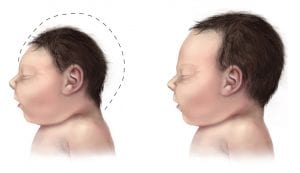Microcephaly has an incidence of 2 to 12 in 10,000 births in the USA and can be diagnosed prenatally via ultrasound (in second or early third trimester) or postnatally via measurement of head circumference (HC). Microcephaly has been linked to developmental delay, seizures, as well as feeding, vision and hearing problems. Prognosis depends on the severity of the microcephaly and whether it is associated with other anomalies.
SMFM – Fetal Microcephaly
CDC – Postnatal Congenital Microcephaly
American Academy of Neurology and Child Neurology Society
Once fetal microcephaly is identified by ultrasound, fetal magnetic resonance imaging, when available and if potential findings are likely to alter pregnancy management, may be considered.
Fetal magnetic resonance imaging images should be reviewed by a radiologist with expertise in fetal magnetic resonance imaging.

Image credit: Centers for Disease Control and Prevention, National Center on Birth Defects and Developmental Disabilities
Microcephaly: An Epidemiologic Analysis
CDC: Congenital Anomalies of the Nervous System: Microcephaly
SMFM: Ultrasound screening for fetal microcephaly following Zika virus exposure
Practice Parameter: Evaluation of the child with microcephaly (an evidence-based review)
SOGC Guideline 380: Investigation and Management of Prenatally Identified Microcephaly
CDC: Zika Virus For Healthcare Providers
Maternal-Fetal Medicine Specialist Locator-SMFM
Are you an
ObG Insider?
Get specially curated clinical summaries delivered to your inbox every week for free
Please log in to ObGFirst to access this page
OBG Project CME requires a modern web browser (Internet Explorer 10+, Mozilla Firefox, Apple Safari, Google Chrome, Microsoft Edge). Certain educational activities may require additional software to view multimedia, presentation, or printable versions of their content. These activities will be marked as such and will provide links to the required software. That software may be: Adobe Flash, Apple QuickTime, Adobe Acrobat, Microsoft PowerPoint, Windows Media Player, or Real Networks Real One Player.
This educational activity may contain discussion of published and/or investigational uses of agents that are not indicated by the FDA. The planners of this activity do not recommend the use of any agent outside of the labeled indications.
The opinions expressed in the educational activity are those of the faculty and do not necessarily represent the views of the planners. Please refer to the official prescribing information for each product for discussion of approved indications, contraindications, and warnings.
Participants have an implied responsibility to use the newly acquired information to enhance patient outcomes and their own professional development. The information
presented in this activity is not meant to serve as a guideline for patient management. Any procedures, medications, or other courses of diagnosis or treatment discussed or suggested in this activity should not be used by clinicians without evaluation of their patient’s conditions and possible contraindications and/or dangers in use, review of any applicable manufacturer’s product information, and comparison with recommendations of other authorities.
It appears you don't have enough CME Hours to take this Post-Test. We no longer offer Hours.
You are now leaving the ObG website and on your way to PRIORITY at UCSF, an independent website. Therefore, we are not responsible for the content or availability of this site
